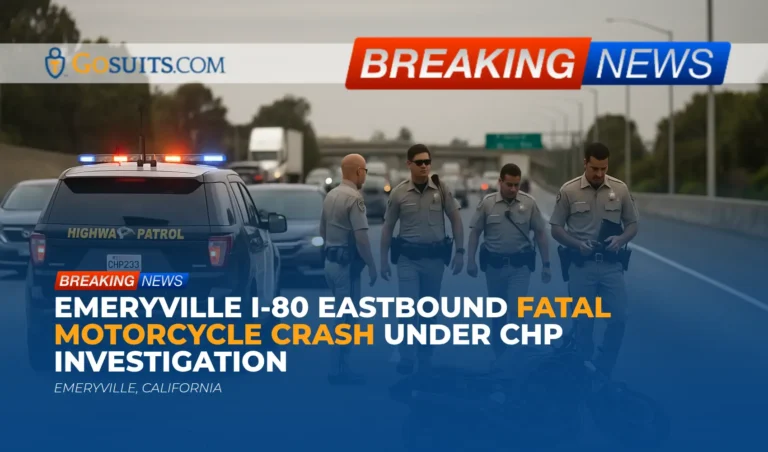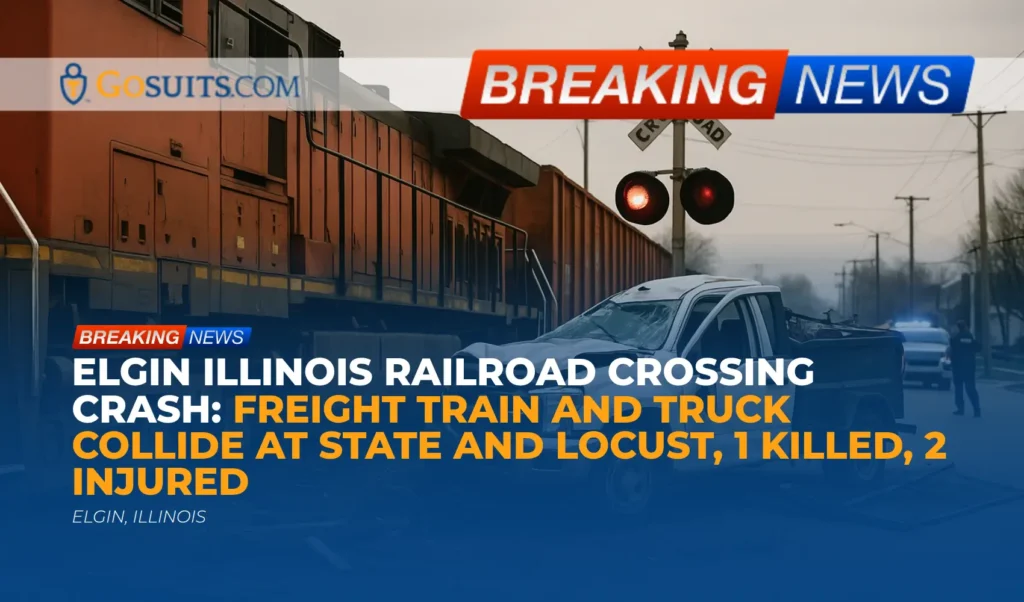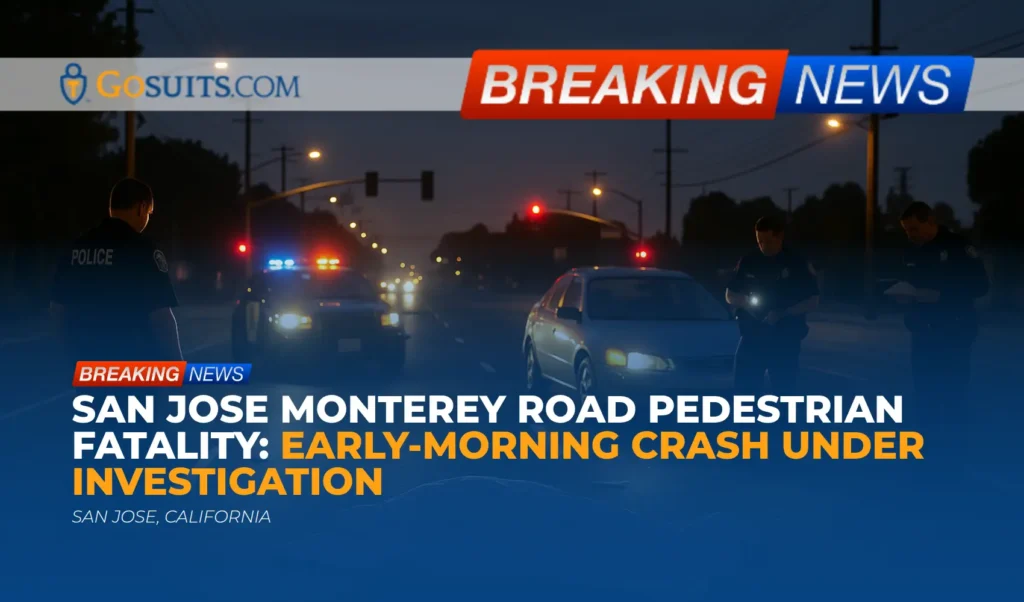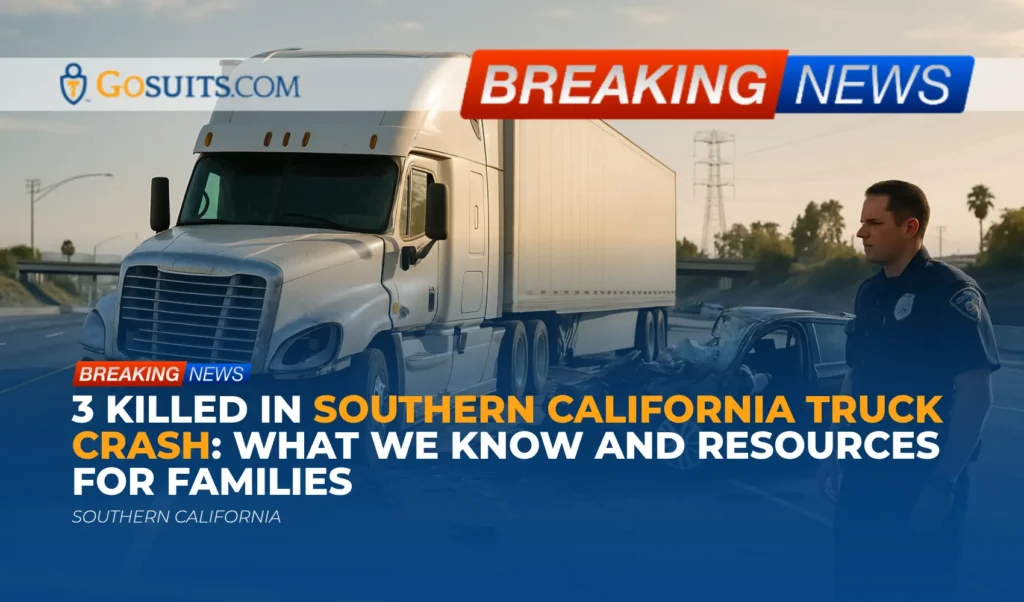- What happened on I-80 in Emeryville
- Official sources and where to get updates
- How families can obtain key records (police report, coroner/autopsy, death certificate)
- Understanding liability in multi-vehicle motorcycle crashes
- Insurance considerations after a fatal motorcycle collision
- Timeline and critical deadlines in California civil claims
- Practical next steps for those impacted
- Roadway safety and motorcycle risk data
- Commentary from Gosuits Emeryville, California Personal Injury Attorney
What happened on I-80 in Emeryville
Authorities responded to a fatal collision involving a motorcycle on the eastbound lanes of Interstate 80 in Emeryville on Sunday afternoon. According to preliminary information, California Highway Patrol officers were dispatched at approximately 2:40 p.m. to the stretch of I-80 just west of Powell Street after reports of a crash involving a motorcycle and another vehicle. Bystander video from the scene showed a heavily damaged motorcycle in one of the traffic lanes. CHP incident logs indicated the collision resulted in a fatality. As of the latest update, officials had not released the identity of those involved or specified who was killed or injured.
In the immediate aftermath, the first, second, and third lanes of the eastbound I-80 were closed while investigators worked at the scene and crews cleared the roadway. Investigations in collisions of this magnitude typically involve documentation of vehicle positions, roadway conditions, witness statements, and retrieval of any available traffic camera or dash-camera footage. These investigations can take time, and public agencies usually release additional information only after next-of-kin notifications and preliminary findings are confirmed.
Official sources and where to get updates
For verified updates and official records, the following sources are commonly used in an incident like this:
- CHP incident and traffic logs: California Highway Patrol’s live traffic incident log provides real-time and recent information on active incidents, lane closures, and clearing times. See CHP Incident/Traffic Log.
- CHP area office information and reports: Collision reports are maintained by CHP and released to authorized parties. The standard request is made via the CHP 190 form. See CHP 190 Application for Release of Information. If unsure which office is handling the report, use the CHP office locator and contact the Golden Gate Division area office that responded to the scene: CHP Find-an-Office.
- Caltrans travel conditions: For lane closures and congestion related to the incident area, Caltrans provides live maps and camera feeds. See Caltrans QuickMap.
Agencies often cannot disclose identity or detailed findings immediately. Families typically receive confirmations through the county coroner’s bureau once next-of-kin notifications are completed.
How families can obtain key records (police report, coroner/autopsy, death certificate)
CHP collision report (police report)
The CHP collision report is one of the most important documents for understanding what investigators recorded at the scene. It typically includes the date and location, parties and vehicles involved, preliminary witness accounts, diagrams, and any citations noted. To request the report:
- Who can request: Typically, involved parties, their legal representatives, and next of kin for a decedent are eligible.
- How to request: Complete the CHP 190 Application for Release of Information. You will need the date, approximate time, location (I-80 eastbound, west of Powell Street, Emeryville), and incident number if available (can often be obtained by calling the local CHP area office noted in the CHP log).
- Where to submit: Submit to the CHP area office that investigated the crash. If uncertain which office handled it, use CHP’s office locator and call the likely Golden Gate Division area office for instruction.
- What to include: Proof of identity and relationship, as applicable. Fees may apply for copies. Processing times vary by office workload and the status of the investigation.
Consider delaying any direct statements to insurance adjusters until you have reviewed the official report and consulted with a lawyer about your rights. What is said early on can be used later in a way that affects civil liability and insurance coverage.
Coroner’s and autopsy information
In fatal collisions in Alameda County, the county coroner’s bureau is responsible for identifying the decedent, notifying next of kin, and determining cause and manner of death. Families may request information about the process, timelines for release, and how to obtain copies of reports. Autopsy and investigative reports can be critical in civil claims because they document injuries, mechanisms of trauma, and time of death.
- Who may receive records: Next of kin typically have priority access to autopsy findings. Some records may be limited during an active investigation.
- What to ask for: Autopsy report, toxicology results if performed, and confirmation of cause and manner of death. Ask about expected timelines, as lab work can take weeks.
- How to contact: Locate the Alameda County coroner’s bureau contact information on the county’s official website; staff can advise on identification procedures, property release, and record requests. Bring government-issued ID and proof of relationship when required.
If religious or cultural considerations affect autopsy timing or organ/tissue donation preferences, communicate that promptly to the coroner’s office.
Death certificates
Death certificates are needed for final arrangements and for handling estate and insurance matters. Certified copies are usually available through the county where the death occurred or through the state.
- Statewide information and ordering: The California Department of Public Health provides statewide guidance on obtaining death certificates. See CDPH Vital Records.
- County process: Families can also request through the county recorder/clerk where the death occurred. Processing times and fees vary.
- Tip: Order multiple certified copies. Insurers, financial institutions, and certain benefit administrators may require originals.
Other potentially important records
- 911 and dispatch recordings: These can clarify response times and initial reports. Availability varies and may require a public records request. Response agencies sometimes limit access during active investigations.
- Traffic camera or roadway CCTV footage: Caltrans and regional transportation agencies may have roadway cameras. Inquire promptly, as footage may be overwritten quickly. See Caltrans QuickMap for camera locations and contact the relevant agency for public records procedures.
- Tow yard documentation: Tow companies often maintain intake photos and item logs. Obtain the name and location of the tow yard from CHP and request preservation of the motorcycle and any onboard devices (dash cams, GPS).

Understanding liability in multi-vehicle motorcycle crashes
Liability in a motorcycle collision typically turns on whether a driver or entity failed to use reasonable care and whether that failure caused harm. In the context of a freeway crash involving a motorcycle and another vehicle, investigators consider factors such as lane changes without clearances, unsafe speed, following distance, visibility, lighting, roadway maintenance, debris, and mechanical failures. Because motorcyclists are less visible, drivers have a duty to perform thorough mirror and blind-spot checks and to yield appropriately.
California allows lane splitting under certain conditions; safe operation and awareness by all drivers is essential. The state encourages safe practices for riders and drivers alike; see general rider safety information at the California DMV’s motorcycle resources: DMV Motorcyclists Resources. The CHP has also published educational materials addressing lane-splitting safety considerations, emphasizing prudent speed differentials and heightened caution: California Highway Patrol.
California uses comparative fault principles, meaning responsibility can be apportioned among multiple parties when each bears some share of blame. The Judicial Council’s civil jury instructions explain that if a plaintiff is partially at fault, recoverable damages can be reduced by that percentage of responsibility. See Judicial Council of California Civil Jury Instructions (CACI) and specifically CACI 405 on comparative fault available via the courts’ site.
In addition to driver negligence, other potential civil factors sometimes examined include:
- Employer liability: If a driver involved was working at the time, their employer may face vicarious liability under respondeat superior, depending on the facts.
- Vehicle defects: Tire, brake, or steering failures could raise product liability questions; evidence preservation is crucial.
- Roadway conditions: Dangerous conditions of public property (e.g., inadequate signage or hazards) carry distinct notice and claims requirements under California’s Government Claims Act.
Because this incident is still developing and officials have not released fault determinations, it is too early to draw conclusions about cause. Preserving evidence and obtaining official records will be central to any later civil analysis.
Insurance considerations after a fatal motorcycle collision
Navigating insurance after a fatal collision is often overwhelming. Several policies and coverages may be implicated:
- Bodily injury liability (other driver): If another motorist is found negligent, their liability policy may provide coverage up to policy limits. Limits vary widely.
- Uninsured/underinsured motorist (UM/UIM): This coverage on the motorcycle’s policy, or sometimes a household auto policy, may apply if the at-fault driver lacks adequate insurance. The California Department of Insurance explains UM/UIM and related consumer rights here: California Department of Insurance – Auto Insurance Guides.
- Medical payments (MedPay): Some motorcycle policies include MedPay, which may provide limited benefits regardless of fault.
- Property damage coverage: Addresses the motorcycle and riding gear. Keep all repair estimates and tow/storage receipts.
- Wrongful death claims: California law allows certain surviving family members to bring a civil claim to recover economic and non-economic losses resulting from a wrongful death. Eligibility is governed by statute; see Cal. Code Civ. Proc. § 377.60 at the official state code website: CCP §377.60.
Before contacting any insurance carrier to give a recorded statement, consider speaking with an attorney. Insurers evaluate statements for admissions against interest and may use early descriptions to limit or dispute claims. A consultation can help you understand what information is appropriate to share and how to document losses.
Timeline and critical deadlines in California civil claims
Civil claims in California carry strict deadlines. Missing a filing window can end a case before it begins. General time frames commonly relevant to traffic fatality cases include:
- Wrongful death statute of limitations: In most cases, a wrongful death action must be filed within two years of the date of death. See Cal. Code Civ. Proc. § 335.1 at the state’s official code site: CCP §335.1.
- Claims against public entities: If a claim involves a public entity (for example, a claim alleging a dangerous roadway condition), the Government Claims Act generally requires a written claim within six months of the incident for personal injury or death claims. See Cal. Gov. Code § 911.2: Gov. Code §911.2.
- Preservation of evidence: Notices to preserve vehicles, electronic data, and third-party footage should be sent as early as possible to prevent loss of crucial information.
Because multiple deadlines can apply at once and different facts can trigger different rules, many families find it helpful to get an early case evaluation so they understand which dates control in their situation.
Practical next steps for those impacted
The hours and days after a fatal crash are a blur. The following steps are practical considerations that may help protect rights while also supporting the immediate needs of those grieving:
- Identify the investigating agency and incident number: Confirm with CHP which area office is handling the report and obtain the incident number. This makes follow-up more efficient. Use the CHP Traffic Log and then call the relevant CHP area office via CHP’s office locator.
- Request the collision report and begin an evidence file: Submit the CHP 190. Keep a binder or digital folder for all communications, receipts, and records.
- Preserve the motorcycle and gear: Ask the tow yard to hold the motorcycle without alterations. Do not authorize repairs until a qualified inspector or attorney has reviewed it. Riding gear, helmets, and intercoms can show impact forces and angles.
- Collect available media and witness contacts: Save any photos, videos, and dash-cam files. If you learn of bystander footage, note names and contact details right away. Footage can be overwritten quickly.
- Funeral and memorial planning: Begin coordinating with the coroner’s bureau on release timelines and with a funeral home of your choice. Order multiple certified death certificates through county or state channels: CDPH Vital Records.
- Insurance notifications: Policies often require “prompt notice,” but consider consulting an attorney first to understand what to report and how. Provide only the basic facts needed to open a claim until you have counsel. Recorded statements are usually not mandatory at the earliest stages.
- Document losses: Track out-of-pocket costs, lost income of survivors, travel for appointments, and counseling expenses. Accurate documentation helps later claims evaluation.
- Avoid public speculation: Refrain from posting about fault or details of the crash on social media. Opposing carriers often monitor public statements.
- Consider supportive services: Bereavement counseling through community or employer programs can provide immediate emotional support while practical matters unfold.
Roadway safety and motorcycle risk data
Motorcyclists face elevated risks on high-speed corridors like I-80 due to exposure and visibility challenges. National data underscores the stakes:
- Scope of the problem: In 2022, 6,218 motorcyclists were killed in traffic crashes nationwide, accounting for 14 percent of all traffic fatalities according to the National Highway Traffic Safety Administration (NHTSA). See NHTSA Motorcycles.
- Risk per mile traveled: NHTSA reports motorcyclists are overrepresented in fatal crashes relative to their share of vehicle miles traveled, reflecting higher vulnerability in any collision.
- Protective equipment: NHTSA estimates that helmets significantly reduce the risk of death and serious head injury for riders and passengers. See safety research and summaries at NHTSA Motorcycles.
California promotes rider safety training and prudent lane-splitting practices. State resources stress that safe lane changes, maintaining reasonable speed differentials, and heightened situational awareness by both riders and drivers can reduce risk. For official motorcyclist education materials and licensing information, visit the California DMV’s motorcyclist page: DMV Motorcyclists Resources.

Commentary from Gosuits Emeryville, California Personal Injury Attorney
Our hearts go out to everyone affected by the fatal collision reported on I-80 eastbound near Powell Street. We are deeply sorry for the loss described. This commentary is intended for educational and general informational purposes to help the community understand how incidents like this are evaluated from a civil injury and wrongful death perspective.
Based on the information publicly available so far, we know only that a motorcycle and another vehicle were involved, lanes were closed for investigation, and a fatality occurred. In a scenario like this, attention typically turns to careful analysis of vehicle movements, lane changes, speed relative to conditions, and visibility. For motorcycles, even minor driver errors by others can have devastating outcomes. At this stage, without official findings, it is important not to speculate about the cause or fault. The collision report, scene measurements, and any video will become central to understanding what happened.
In our experience, insurance companies and corporate risk managers move quickly after serious crashes. They often seek early statements, ask broad medical or background questions, and request authorizations that are not required at the outset. Adjusters may position discussions around potential comparative fault, regardless of whether that ultimately fits the facts. This can leave grieving families feeling pressured and uncertain. Taking time to understand coverage, preserve evidence, and review official reports before providing detailed statements can make a meaningful difference in how claims are evaluated later.
A free consultation with a seasoned injury attorney can help families understand options, timelines, and immediate steps that protect their rights. It is not about filing a lawsuit on day one; it is about learning what information to gather, what to avoid saying prematurely, and how to ensure crucial evidence is not lost. Even if a family decides not to pursue a claim, early guidance can prevent avoidable missteps with insurance communications or deadlines.
Why acting promptly matters
- Evidence disappears quickly: Freeway camera loops overwrite, vehicles are repaired or salvaged, and debris is cleared. Prompt preservation letters and targeted requests can secure photographs, event data, and third-party video before it is gone.
- Multiple deadlines can apply: California’s two-year wrongful death statute is only one clock. Government claims for roadway condition allegations carry a six-month presentment requirement, and insurance policies may have prompt-notice provisions. Missing a deadline can limit recovery or end a claim.
- Insurer positioning starts early: Carriers begin evaluating fault and reserves as soon as they learn of a crash. Early, careful communication can avoid admissions or authorizations that are not required and that could be used to minimize a claim.
- Securing benefits and arrangements: Planning for funeral and estate matters requires certified death certificates and coordination with the coroner. Understanding what documents to request and when reduces delays during an already difficult time.
- Clarity for the family: A structured plan helps reduce uncertainty. Knowing which records to request, what to document, and how to handle calls from adjusters provides some measure of control in a difficult moment.
If an insurance claim will be pursued, consider consulting an attorney before speaking in detail with insurers. What is said to an insurance company can be used later and may affect fault assessments and coverage decisions. A no-cost case review can provide clarity about the process and the timing of next steps.






